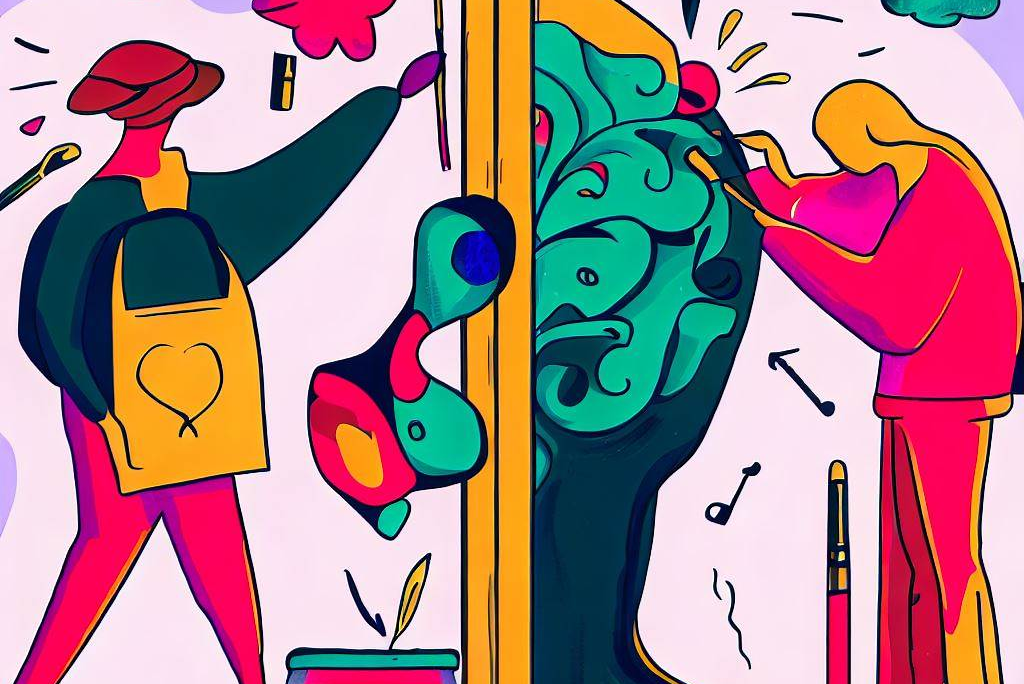Introduction
In today’s fast-paced world, finding solace and peace of mind can seem like an elusive quest. But what if I told you that the answer lies within the strokes of a paintbrush? Art has long been celebrated for its ability to heal, inspire, and unleash the power within us. In this article, we explore the profound impact of art on mental health and how it can serve as a therapeutic tool to navigate the challenges of life.
With each colorful stroke and deliberate brush movement, we delve into a realm of self-expression and self-discovery. Art invites us to explore our emotions, confront our fears, and find our voice amidst the chaos. It allows us to communicate feelings that are often too deep for words and to unearth hidden layers of our subconscious.
:max_bytes(150000):strip_icc()/Stocksy_txp44fe9542TqK100_Medium_1248806-588788305f9b58bdb326bb98.jpg)
Research has shown that engaging in artistic endeavors can reduce stress, enhance cognitive abilities, and boost self-esteem. It provides an outlet for emotional release and cultivates mindfulness, allowing us to be present in the moment and find respite from our anxieties.
So whether you’re picking up a paintbrush, kneading clay, or capturing a moment through photography, remember that art has the potential to heal wounds that are invisible to the naked eye. It is a testament to the power of creativity and the resilience of the human spirit.
The connection between art and mental health
Art and mental health have an intricate and profound connection. Engaging in artistic activities has been found to have numerous benefits for mental well-being. Artistic expression offers a unique way to channel emotions and thoughts, providing individuals with a means to cope with stress, anxiety, and depression. The process of creating art can be cathartic, serving as a form of release and helping individuals gain a sense of control over their emotions.
Furthermore, art provides an avenue for self-reflection and introspection. Through art, individuals can explore their inner world, confront unresolved issues, and gain a deeper understanding of themselves. This process of self-discovery can be transformative and can lead to personal growth and healing.
The healing power of self-expression through art
Art has the remarkable ability to tap into our innate capacity for self-expression. When words fail us, art becomes a language of its own. It allows us to communicate our emotions, experiences, and perspectives through visual representations. Whether it’s through painting, drawing, sculpting, or any other artistic medium, self-expression through art can be a powerful tool for emotional release and healing.
Artistic expression enables us to externalize our internal struggles and transform them into something tangible and visible. It gives us the opportunity to process complex emotions, such as grief, trauma, or heartbreak, by creating a visual narrative of our experiences. Through art, we can find solace, gain clarity, and reclaim our power.
How art therapy can reduce stress and anxiety
Art therapy, a discipline rooted in psychology and creative expression, harnesses the therapeutic potential of art to promote mental well-being. It provides individuals with a safe and supportive environment to explore their emotions, gain insight, and develop coping mechanisms. Art therapy techniques can help reduce stress and anxiety by engaging the mind, body, and emotions in a creative process.
By engaging in art therapy, individuals can shift their focus from distressing thoughts and worries to the act of creation. This redirection of attention helps to alleviate stress and anxiety, allowing individuals to experience a sense of calm and relaxation. The process of creating art also promotes the release of endorphins, which are natural mood-enhancing chemicals in the brain, further contributing to a reduction in stress and anxiety levels.
Art as a tool for emotional healing and trauma recovery
Art has long been recognized as a potent tool for emotional healing and trauma recovery. Traumatic experiences can leave deep emotional wounds that may be difficult to express or process verbally. Art offers a safe and non-threatening medium through which individuals can explore and process their traumatic experiences.
Through art therapy, trauma survivors can externalize their experiences and gain a sense of control over their narratives. Artistic expression allows individuals to create new meanings and interpretations of their experiences, empowering them to redefine their identities beyond their traumatic past.
The role of art therapy in improving self-esteem and self-awareness
Art therapy has been shown to have a positive impact on self-esteem and self-awareness. Engaging in artistic activities provides individuals with an opportunity to challenge negative self-perceptions and develop a more positive self-image. The act of creating art fosters a sense of accomplishment and mastery, boosting self-confidence and self-esteem.
Furthermore, art therapy encourages self-reflection and introspection, facilitating a deeper understanding of oneself. By exploring one’s thoughts, emotions, and experiences through art, individuals can gain insight into their strengths, vulnerabilities, and personal growth opportunities. This increased self-awareness lays the foundation for personal development and a greater sense of self-acceptance.
Art therapy techniques for promoting mindfulness and relaxation
Art therapy offers a variety of techniques that promote mindfulness and relaxation. Mindfulness is the practice of being fully present in the moment, without judgment. Engaging in art can be a meditative experience, drawing individuals into a state of focused attention and heightened awareness.
One technique commonly used in art therapy is the practice of mindful drawing or painting. This involves paying close attention to the sensory experience of creating art, such as the texture of the materials, the sound of the brush against the canvas, and the colors blending together. By immersing themselves in the process, individuals can achieve a state of flow, where time seems to stand still, and worries fade away.
The benefits of art therapy for various mental health conditions
Art therapy has demonstrated benefits for a wide range of mental health conditions. It has been shown to be effective in reducing symptoms of depression, anxiety, and post-traumatic stress disorder (PTSD). Art therapy can provide individuals with a safe outlet to express their emotions, gain insight into their experiences, and develop healthy coping mechanisms.
For individuals with neurodevelopmental disorders, such as autism spectrum disorder or attention deficit hyperactivity disorder (ADHD), art therapy can be particularly beneficial. Engaging in art allows these individuals to improve their focus, enhance their communication skills, and develop their emotional regulation abilities.
Finding art therapy resources and professionals
If you’re interested in exploring art therapy, there are various resources and professionals available to guide you on your journey. Art therapists are trained professionals who combine their knowledge of psychology and art to provide therapeutic support. They can help you navigate your emotions, develop coping strategies, and unlock your creative potential.
Art therapy can be accessed through individual sessions, group therapy, or community programs. Many art therapy organizations and centers offer workshops and classes for individuals of all ages and skill levels. Additionally, there are numerous online resources, books, and art therapy exercises that you can explore from the comfort of your own home.
Conclusion: Embracing the therapeutic potential of art
Art has the power to heal, inspire, and transform. It offers a unique and powerful means of self-expression, enabling individuals to navigate the complexities of their emotions and experiences. Through art, we can find solace, gain insight, and unleash the power within us.
Whether you’re picking up a paintbrush, kneading clay, or capturing a moment through photography, remember that art has the potential to heal wounds that are invisible to the naked eye. It is a testament to the power of creativity and the resilience of the human spirit.
By embracing the therapeutic potential of art, we can cultivate our mental well-being, nurture our self-expression, and embark on a journey of self-discovery. So let the healing brushstroke guide you towards a brighter and more fulfilling life.



